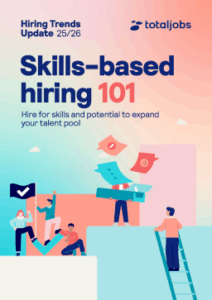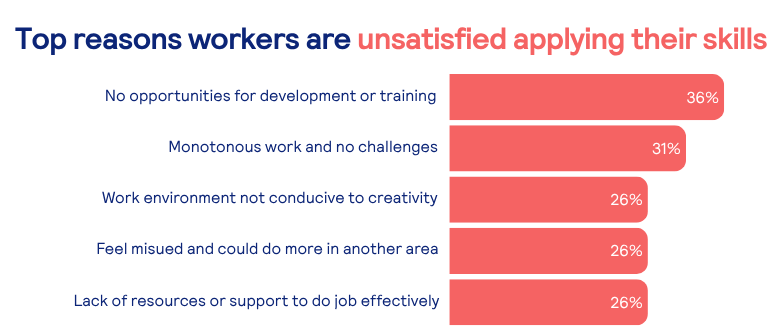
How to upskill employees
Table of Contents
- Key takeaways
- The benefits of upskilling
- Upskilling and reskilling
- How to upskill your workforce
- The challenges of upskilling
- Making upskilling a strategic priority
- FAQs

Skills Based Hiring Template
In a labour market defined by rapid change and skills shortages, it’s no wonder that finding candidates with the right skills is an issue for 70% of recruiters.
As well as utilising skills-based hiring to plug gaps, employers can look to upskill their existing workforce. In this article, we’ll outline the practical steps you can take to do just that.
Key takeaways
- Upskilling is a strategic response to talent shortages and evolving demands
- 14% of workers say they aren’t using their skills fully, rising to 22% for those aged 50–59
- Both soft skills (e.g. collaboration and critical thinking) and technical skills (e.g. programming and data analysis) are essential for workforce resilience
- 70% of recruiters say finding candidates with the right skills is a challenge
The benefits of upskilling your workforce
Before delving into how you can start to upskill your employees, let’s first look at the benefits you can unlock with a dedicated, comprehensive upskilling programme.
Boost retention and engagement
Upskilling isn’t just about filling gaps. It’s also about keeping employees motivated and productive.
Our research shows that 14% of workers feel they’re not applying their skills in their current role, a number that rises to 22% among 50–59-year-olds.

By investing in learning initiatives, employers can re-engage experienced talent, reduce attrition and create a more fulfilling employee experience.
Enhance agility and innovation
A workforce that is on a continuous learning journey will inevitably be better equipped to handle things like:
- Market shifts
- Emerging technology
- Evolving customer needs
Furthermore, upskilling employees can help them move beyond routine tasks and into creative, strategic work. This is particularly important considering that 26% of workers unsatisfied with how their skills are being applied say their work environment doesn’t support innovation.
Close skills gaps
With employers grappling with the potential of emerging and evolving technologies like AI, skills gaps are only likely to increase.
With the labour market struggling to keep pace with these developments, internal upskilling reduces dependency on external hiring, helping teams meet evolving benchmarks in both technical and soft skill domains.
Strengthen employer branding
A visible commitment to employee growth can send a powerful message to candidates and can make your organisation a more appealing place to work.
Upskilling supports this inclusive approach, positioning your organisation as a destination for continuing professional development.
How does upskilling differ from reskilling?
The terms are often used interchangeably, but they describe distinct approaches to workforce development:
- Upskilling focuses on enhancing existing skills or adding new ones within an employee’s current role. For example, a marketing professional learning advanced data analytics to improve campaign performance. It’s about deepening expertise and keeping pace with evolving demands.
- Reskilling involves training employees to take on entirely new roles, often in response to structural changes or automation. For instance, retraining administrative staff to move into customer success or IT support roles. It’s about redeploying talent to different functions.
For HR leaders, the distinction matters. Upskilling helps employees grow within their current career path, boosting engagement and retention. Reskilling, meanwhile, provides agility when business models shift or new technologies disrupt existing roles.
Together, they form a holistic talent strategy that ensures organisations can adapt to both incremental and transformational change.
How to upskill your workforce: 8 proven strategies
Now we’re clear on why upskilling is crucial from an employer’s perspective, let’s examine the steps and strategies you can implement to successfully upskill your existing employees.
1. Conduct a skills gap analysis
Before launching any new upskilling initiative, first you need to have clarity on where things currently stand and what’s missing.
Start by auditing current roles and mapping them against future needs. This isn’t about job descriptions. It’s about the capabilities people in these roles need every day.
Performance reviews and digital assessments can help to capture both technical and soft skills among the existing workforce, while structured, competency-based interviews can help identify these in new hires.
Once gaps have been identified, prioritise those that impact strategic goals and/or customer outcomes.

Top tip: Involve line managers when possible. They understand where the friction lies and which skills are holding teams back.
2. Align upskilling with business objectives
Upskilling won’t succeed as a standalone HR project. Instead, it needs to be embedded within your organisation’s strategic roadmap.
For example, if your organisation is looking to expand into new markets or launching AI-driven projects, for example, which capabilities will be critical? Collaborate with department heads to define these and build learning programmes that directly support them.
This alignment not only ensures buy-in from leadership, but it also makes it easier to measure return on investment (ROI).

Top tip: Avoid generic training. Focus on solving real problems, whether that’s improving data fluency or boosting cross-functional collaboration.
3. Invest in learning platforms
Digital learning platforms are increasingly the backbone of scalable upskilling.
Look for platforms that provide modular content, mobile access and, crucially, integration with your existing HR systems wherever possible.
Also crucial are systems that:
- Allow personalised learning journeys
- Track progress
- Provide analytics on engagement and outcomes
4. Encourage learning and mentorship
Upskilling represents a great opportunity for knowledge sharing and growth across the workforce.
For example, internal mentoring programmes that pair experienced colleagues with those looking to grow can benefit both sets of employees, helping to develop skills like:
- Communication
- Leadership
- Problem-solving
Informal learning can also contribute to upskilling programmes, with initiatives like lunch-and-learns, cross-team shadowing and internal webinars.

Top tip: Recognise mentors publicly and include mentoring contributions in performance reviews to reinforce their value.
5. Create personalised pathways
Generic training plans often fall flat. Instead, tailor development to:
- Individual goals
- Roles
- Learning styles
You can start by using skills assessments and career conversations to understand employee’s aspirations, and then develop a learning plan that includes a mix of formats, such as:
- Online courses
- Stretch assignments
- Coaching
- Peer learning
For employees who feel creatively stifled, offer opportunities to lead projects, experiment with new tools or contribute to innovation initiatives. This can be particularly useful to support those who say their work environment is not conducive to creative work.

Top tip: AI-powered platforms can help recommend content and track progress, but human guidance remains key.
6. Promote a culture of continuous learning
Upskilling isn’t a one-off campaign. It needs to become a mindset.
This can be achieved by embedding learning into everyday work. To do this, consider:
- Encouraging managers to set learning objectives during 1:1s and team meetings
- Celebrate curiosity by highlighting employees who’ve applied new skills to solve problems or improve processes
- Creating a “learning leaderboard” or monthly spotlight to showcase progress and inspire others
7. Measure and reward progress
For learning to really stick, you need to track it. And reward it.
Where possible, start by using your learning platform’s analytics capabilities to monitor completion rates, skills acquisition and application on the job, but go beyond the numbers. Gather qualitative feedback on how learning has impact confidence, performance or collaboration.
Then, work to link learning achievements to tangible outcomes, such as:
- Promotions
- Pay rises
- Public recognition
8. Integrate upskilling into career development plans
Upskilling should become a formal part of performance reviews and succession planning programmes.
For each role, define the skills required for progressions and make these visible to employees. To further support this, you can offer secondments, lateral moves or project-based roles that allow people to apply new skills in different contexts.
These initiatives can not only support retention, but also build a more agile, future-ready workforce.
The challenges of upskilling your workforce
While there are clear benefits to upskilling employees, employers often encounter barriers when trying to embed a culture of continuous learning across their organisations, including:
- Budget constraints and proving ROI: Learning initiatives can be seen as costly, especially when budgets are tight. HR leaders need to demonstrate measurable outcomes, such as improved retention, reduced recruitment costs, or productivity gains, to secure investment.
- Low employee engagement: Even the best-designed programmes can fail if employees don’t see the relevance. To overcome this, link learning directly to career progression and make it accessible through flexible formats such as microlearning or mobile platforms.
- Keeping pace with technological change: Skills requirements evolve rapidly, particularly in areas like AI, data literacy and digital transformation. Employers must regularly refresh training content and ensure managers are equipped to support employees in applying new skills.
- Cultural resistance: In some organisations, employees may view learning as optional or secondary to their day-to-day work. Building a culture of continuous learning, where managers model behaviours and achievements are recognised, helps shift this mindset.
By anticipating these challenges and addressing them proactively, HR teams can ensure upskilling programmes deliver long-term impact rather than short-term fixes.
Making upskilling a strategic priority
Upskilling is no longer just an HR initiative. It’s a board-level agenda item that underpins workforce planning, DEI goals and long-term competitiveness. Organisations that embed learning into their DNA will be better positioned to adapt to technological disruption, attract top talent and retain experienced employees.
By building cross-functional coalitions, aligning programmes with business objectives, and measuring impact rigorously, HR leaders can transform upskilling from a tactical fix into a strategic advantage. In 2026 and beyond, the organisations that thrive will be those that don’t just ask how to upskill their workforce, but act decisively to make it a cornerstone of their future success.
Frequently asked questions (FAQs)
Why is upskilling important in 2026?
With Totaljobs research showing that 70% of recruiters are struggling to find candidates with the right skills, upskilling helps organisations close skills gaps internally, reduce reliance on external hires and stay competitive in a rapidly evolving market.
How does upskilling support diversity, equity and inclusion (DEI)?
Upskilling creates equal opportunities for career growth, supports non-traditional candidates and helps career changes access roles without requiring formal qualifications.
What is the difference between upskilling and reskilling?
Upskilling enhances existing skills or adds new ones within an employee’s current role, while reskilling prepares employees for entirely new roles, often in response to organisational or market changes,
What skills should employers prioritise when upskilling?
Both soft skills (communication, problem-solving, critical thinking) and technical skills (data analysis, programming, AI literacy) are essential for workforce resilience in 2026.
Receive the latest recruitment resources and
advice to boost your hiring
By providing us with your details you agree to our privacy policy and for us to keep you updated with the latest news, events,
and special offers from Totaljobs.








